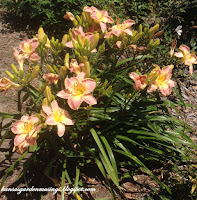 Flowers occasionally pop up in the most surprising places, sometimes in places where we should expect them, but where we least expect them. Indulge me, for a moment, and imagine that you have had a nice foliage plant in your office for eight or ten years, a plant that struggles to gain sunshine and one that you occasionally overwater or underwater to the brink of death. Imagine that it occasionally puts out a new shoot, but otherwise grows extremely slowly, fighting for every inch of its precarious life. Now imagine your astonishment when you are on the phone one day, engaged in a quite boring conversation, and you look over and see this strange, alien thing hanging from your office plant.
Flowers occasionally pop up in the most surprising places, sometimes in places where we should expect them, but where we least expect them. Indulge me, for a moment, and imagine that you have had a nice foliage plant in your office for eight or ten years, a plant that struggles to gain sunshine and one that you occasionally overwater or underwater to the brink of death. Imagine that it occasionally puts out a new shoot, but otherwise grows extremely slowly, fighting for every inch of its precarious life. Now imagine your astonishment when you are on the phone one day, engaged in a quite boring conversation, and you look over and see this strange, alien thing hanging from your office plant.I found myself in that exact scenario last week, when I saw the really strange looking structure shown above as it appeared hanging off my Hoya carnosa plant last week. Hoya carnosa, also known as the Wax Plant, is about the only plant that can survive my fluorescent prison confines with me, and I actually grow two of them in my office for the dual purposes of extending my Seventies back-to-nature office decor and of advertising my gardening prowess in that most unlikely of places.
I wasn't aware that this plant would flower, but if I had known one of its alternate aliases, Porcelainflower, then my surprise might have been muted. Hoya carnosa does flower infrequently, and these perennial structures are known as spurs. Spurs, I'm told, should not be damaged because the plant will flower annually from this same spur and the spur and resulting flowers will get longer as it gets older. Thick-petaled, waxy flowers on my single spur opened eight days after I first noticed the buds (see the photo below), and they are a fabulous star-within-a-star-shape and scented with, I swear to Mother Nature, the scent of delicious chocolate. Native to east Asia and Australia, H. carnosa is able to adapt to bright light, but it can tolerate much lower levels as an indoor plant. It is said to be an excellent remover of pollutants in the indoor environment, and I can surely use all the clear air at work that I can obtain.
I believe that my Hoya is H. carnosa variegata, a variety with white-edged leaves. I was surprised all over again today when I googled the plant and found the variety of cultivars that are available. Like nearly everything else on this earth, Hoyas have their own afficionados, and I ran across a website run by someone named Christina that will open your eyes on the Hoyas. Now, unfortunately, I've fallen down the rabbit hole and I've got to look for some of the other cultivars that I've seen described during my search. There is always a new twist awaiting a plant collector prone to passions.















































